Sustainable Labs

In the course of running our daily operations, our university uses energy and produces waste. This is also the case across our laboratoria. Laboratories have an exceptionally high impact on the environment due to their high energy demand and large amount of poorly recyclable, and potentially hazardous waste output. Due to the heterogeneous nature of the labs at the UT, a bottom-up or tailor-made approach is required to effectively reduce the CO2 footprint.
Although allowing our primary processes - education & research - to continue unhindered at all times is paramount, we work hard on minimizing the impact of our labs on our environment and climate. Our ultimate goal is to be able to conduct research at the university with as little negative impact on the environment as possible.
- In 2023, S&T faculty appointed a Sustainable Labs coördinator to reduce the impact caused by our lab activities.
- In 2024, UT managed to shut down a ultra-low temperature freezer in the labs, saving 6000 kWh (the equivalent of 2 Dutch households) in the process.
- Alarms on fume hoods in Carré reduced CO₂ emissions by 42 tons per year.
Sustainable labs Across campus
- Carré
Fume hoods
Fume hoods are designed to contain volatile and harmful substances by drawing in large volumes of air, similar to a kitchen exhaust hood but within a sealed enclosure. However, this high air intake has both a financial and environmental cost. A single fume hood uses around 15,600 cubic meters of air per day, which equates to roughly €10 in energy costs and emits around 21 kg of CO₂.
At the Carré building, the fume hoods are equipped with variable airflow systems that automatically reduce air intake when the window (sash) is closed. To encourage users to keep the windows closed when not in use, stickers have been placed on the glass, and an alarm is triggered if the sash remains open for longer than 10 minutes.
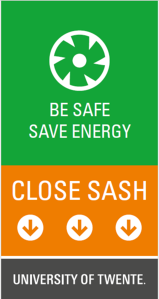
Over the course of one year, this initiative saved approximately €20,000 and reduced CO₂ emissions by 42 tons. These savings are structural, as long as users consistently close the fume hood windows after use.
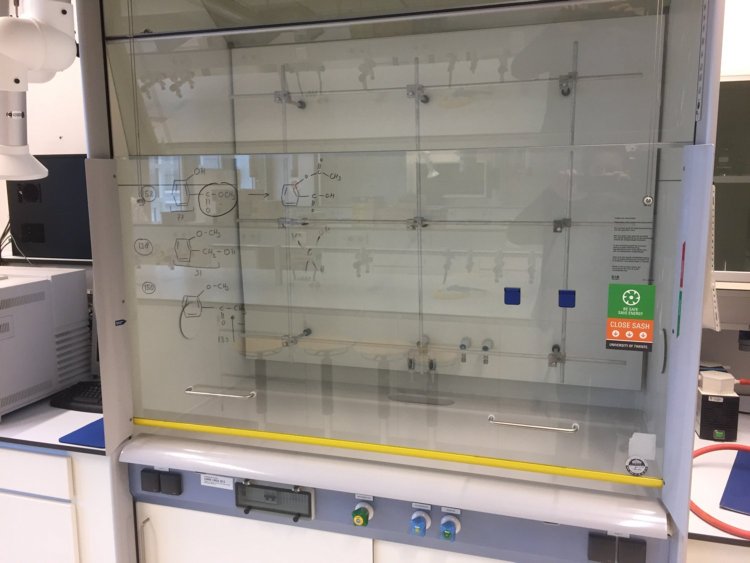
- Meander
Pilot: Smart ventilation
In the Meander building, it is challenging to achieve energy savings with fume hoods, as they do not automatically reduce air intake when the sash is closed. To address this issue and reduce energy consumption for air treatment in the Meander labs, the decision has been made to decrease overall ventilation in the lab spaces after office hours and on weekends. This reduction is managed on a room-by-room basis and can be overridden by users when work needs to be conducted outside of regular hours.
The advantage of this approach is that it allows for greater air savings than simply closing the fume hoods, leading to significantly higher energy savings. It is estimated that this smarter ventilation strategy will result in savings between €80,000 and €200,000, as well as a reduction of approximately 1,350 tons of CO₂ emissions entering the atmosphere.
The first test lab has already been equipped with the necessary hardware to facilitate air savings. It is expected that the plans will be operational by early 2025, at which point the energy savings can commence.
More about Sustainable labs
Sustainable Labs coördinator
Sustainability is an increasingly hot topic at UT. Our laboratories use a lot of energy and also produce a lot of waste. This can be done differently, according to Rolf Slaats. He has been full-time sustainable labs coordinator at the TNW faculty for some time now. "My ultimate goal is that we can carry out the same research here at UT in the future as we do now, but without the negative impact on the environment."
UT shuts down ultra-low temperature freezer
Thanks to a great collaboration between the S&T Faculty Green Hub, Green Hub Twente, the SEE-programme and the research groups Applied Stem Cell Technologies (AST), Developmental BioEngineering (DBE), and NanoBioPhysics, UT shut down a ultra-low temperature freezer.
First LEAF-accreditations handed out by UT
The Laboratory Efficiency Assessment Framework (LEAF) provides guidelines for more sustainable practices in laboratories. Raising awareness and building a collaborative community are crucial elements in this effort. The LEAF initiative is part of a broader plan at the University of Twente, aimed at making all laboratories more sustainable.
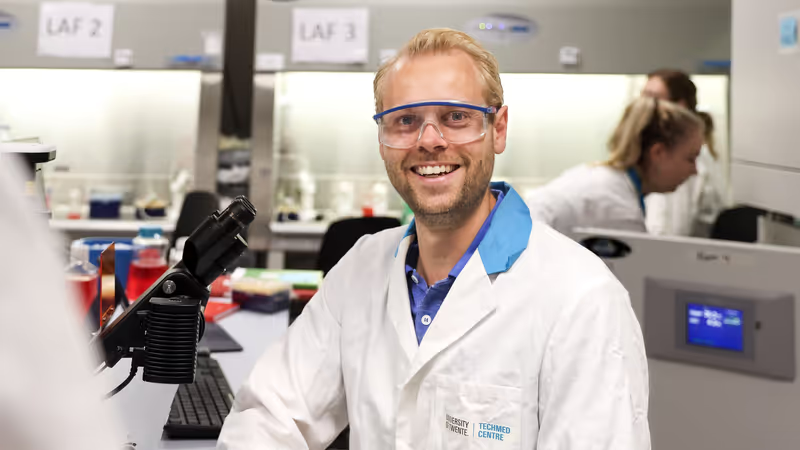


What can you do?
Do your part! Help us reduce our negative impact on the environment caused by our labs. But where to start? Use the list compiled below for some inspiration regarding certain sustainability themes in our labs. Do you have any specific questions or ideas? Feel free to contact the Sustainability policy advisors. We're very happy to help! Together, we can do more than we think. Let's make it happen!
- Energy
Turning Off Equipment
Turning off equipment after use is a simple way to save energy and extend the lifespan of devices. Here are several methods to encourage this within your work environment:
- Stickers and instructions: Stickers with power-down protocols can be placed on equipment to remind users of the importance of turning devices off. These stickers are available on this page (see: resources) or can be requested as custom designs bij Jessica van de Vosse. The stickers are designed to be easily printed on Avery L7060 label sheets using a Xerox printer. Lab managers or users can place the stickers themselves, as they are best positioned to determine where and how these should be applied.
- Set devices to standby: Where possible, devices such as monitors can be set to standby mode when not in use. This offers additional energy savings without sacrificing convenience.
Sustainable Purchasing of Equipment
When purchasing new equipment, sustainability should be considered. Here are a few key points:
- Energy label: Always check the energy label of devices to assess their energy consumption.
- ACT label: The ACT label goes beyond energy usage and provides information on the overall environmental impact of the product, from production to disposal. This helps you compare devices and make more sustainable choices.
- Inquire about sustainability: Ask suppliers (or their account managers) about the sustainability features of equipment. For major purchases or tenders, you can even include sustainability criteria, encouraging suppliers to provide more transparent and accessible information about their products.
Optimizing Lighting
Although the lighting in offices, corridors, and labs is often managed by Campus Facility Management (CFM), there are still ways to contribute to efficient lighting use:
- Motion sensors and timers: Many spaces are equipped with sensors and timers that automatically switch off lights when no one is present. If a sensor is not functioning properly, or if you identify a space where one could be installed, report the issue to the service desk or building manager.
By following these steps, we can collectively contribute to more sustainable use of equipment and lighting in laboratories. If you have questions or need resources such as stickers or templates, feel free to contact the sustainability policy officers.
- Waste
Laboratories can generate significant amounts of waste, particularly when single-use (sterile) items are involved. Due to the potential hazards associated with lab waste, it requires a different approach from household waste. However, there are many ways to improve waste management in labs.
Waste Separation: Using PD Bins
A key improvement in waste management is the separation of packaging materials from general waste. This can be done safely and easily by placing an extra bin for PD (plastic and drink packaging) waste. In consultation with cleaning service Asito, these bins can be emptied regularly, and you can decide where to place them so they are useful but not obstructive. PD waste is free to dispose of and can be recycled, so separating this waste stream is strongly encouraged. TNW-AMH has already started an initiative to distribute PD bins across labs—contact them to explore your options!
For questions about other types of waste or additional waste streams, it’s best to reach out to the sustainability policy officers. In many cases, arrangements can be made to collect specific materials separately, but this will need to be coordinated with our waste processor and the facility management team.
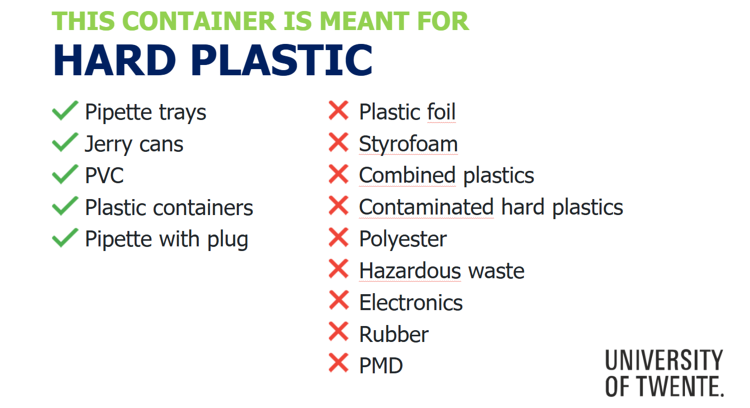
Waste Reduction: The R-Ladder of Circularity
The most effective way to manage waste is to produce less of it. A helpful framework for this is the R-Ladder of Circularity, which encourages you to think critically about reducing material use. Consider whether you can:
- Reduce: Use fewer materials overall.
- Reuse: Find ways to reuse items instead of disposing of them after a single use.
- Repair: Fix equipment or materials, rather than replacing them.
In addition, you can make more sustainable choices when ordering supplies:
- Packaging: Choose suppliers that use less packaging or explore bulk ordering options. This reduces the amount of packaging and the number of deliveries needed.
- Supplier agreements: In some cases, it’s possible to negotiate with suppliers to reduce packaging or adjust delivery schedules. This may require small changes to your work protocols, but it can lead to significant environmental and cost savings over time. Contact sustainability@utwente.nl if you need help or have questions regarding this topic.
By separating waste streams, particularly through the use of PD bins, and reducing waste generation through thoughtful procurement and use of materials, we can make laboratory operations more sustainable. Waste separation, recycling, and reduced material consumption not only benefit the environment but also contribute to cost savings across the board.
- Water
Increasing periods of drought during the summer months have led to temporary shortages of drinking water. To address this issue, the Dutch parliament has asked all major water consumers to reduce their water usage by 20% by 2035, compared to the baseline year of 2019. As a significant user of water, the University of Twente (UT) is committed to meeting this target.
In laboratories, process water is drawn from the mains water supply for various activities. Below are some key ways you can contribute to water conservation in your lab:
Optimize the Use of Dishwashers and sterilisation equipment (autoclaves)
- Only run full loads: To maximize efficiency, ensure that dishwashers and autoclaves are only run when they are fully loaded. This reduces the number of cycles and minimizes water usage over time.
Switch to Closed-Circuit Cooling
- Don't use mains water for cooling: Some labs use mains water for cooling, but this can be replaced by closed-circuit cooling systems, which recycle water within the system. This greatly reduces the amount of water consumed.
Minimize the Use of Demineralized Water (Demiwater)
- Be selective with demiwater: Producing 1 liter of demineralized water (demiwater) requires 3 liters of mains water. Therefore, only use demiwater when absolutely necessary, and consider if regular mains water can suffice for certain tasks.
The Impact of Your Actions
By adopting these simple yet effective measures, we can significantly reduce water consumption in labs without compromising on the quality of our work. Reducing water usage not only helps to meet the national target but also supports broader environmental sustainability goals.
If you have any questions about implementing these practices or need guidance on more water-saving opportunities, please reach out to the sustainability policy officers. Together, we can contribute to a more sustainable future.
- Vegan Science
In biological laboratories, many common materials are still derived from animal sources. Examples include Fetal Bovine Serum (FBS/FCS), antibodies, and extracellular matrices like Matrigel, GelTrex, and gelatin. These animal-derived products not only have a significant environmental impact—due to the high carbon footprint associated with raising livestock—but also raise ethical concerns. Globally, it is estimated that 2 million unborn calves are sacrificed annually for the production of FBS, highlighting the ethical dilemma of using animal products in research.
Ethical and Sustainable Alternatives
One of the most effective ways to address these concerns is by replacing animal-derived materials with vegan alternatives. For instance:
- Fetal Bovine Serum (FBS) can be replaced with synthetic (Knock-out Serum replacement or KOSR) alternatives that provide comparable growth support for cell cultures.
- Antibodies produced via recombinant technologies (not requiring animals) offer a viable and ethical substitute for traditional antibody production.
- Extracellular matrices made from plant-based, recombinant proteins or synthetic materials can replace animal-derived substances like Matrigel or gelatin.
A simple analogy is the replacement of cow’s milk with soy milk—a straightforward switch that significantly reduces both the environmental and ethical footprint of lab work.
Why Transition to Vegan Science?
- Environmental Impact: The production of animal-based materials is resource-intensive, contributing to higher CO2 emissions and environmental degradation. Reducing reliance on animal products can lower the carbon footprint of research activities.
- Ethical Responsibility: Moving away from the use of animal-derived products aligns with growing societal concerns about animal welfare. Adopting vegan alternatives demonstrates a commitment to more humane and ethical research practices.
- Consistency: Animal-derived products can vary significantly between batches, making them inconsistent for many applications. In contrast, synthetic or recombinant human products offer more consistent production, can be tailored more precisely for specific uses, and are often more relevant to human biology.
You can make a meaningful impact by critically assessing the materials you use and seeking out vegan alternatives. Many companies now offer plant-based or synthetic options for common lab reagents, making it easier than ever to transition to more ethical and sustainable practices.
If you have any questions about vegan alternatives in your lab or need guidance on making the switch, don't hesitate to reach out to the sustainability policy officers. Together, we can foster a more ethical and environmentally responsible scientific community.
- Procurement
The procurement department aims to incorporate sustainability into the purchasing process for lab materials. You can contribute to this effort.
If you notice inefficienties in the purchasing process (2 deliveries on the same day), that certain products have excessive packaging or that grey Styrofoam is being used (only white styrofoam can be recycled), please report this to the sustainability policy officers. They can then reach out to suppliers to discuss more sustainable packaging options.
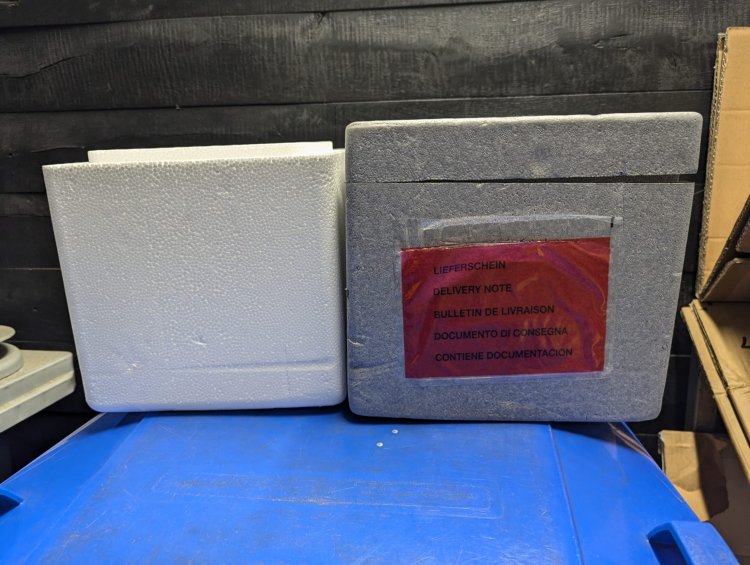
Your observations can help improve the sustainability of our purchasing practices on campus.
- Substances of High Concern (ZZS)
The chemical registration system provides insight into substances we use that impact the environment (ZZS) or human health (CMR: carcinogenic, mutagenic, reprotoxic). Often, a CMR substance is also classified as a ZZS.
To reduce the impact on the environment, as well as reducing risks in and around the labs, we are actively seeking alternatives to these ZZS/CMR substances. This process is challenging and requires input from all lab users. We encourage you to ask yourself each time: Is this substance necessary, or can I choose an alternative?
- LEAF-framework
Implementation of Laboratory Efficiency Assessment Framework (LEAF)
in all S&T groups provides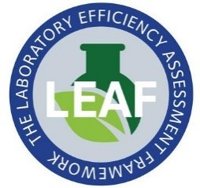 guidelines for better sustainable practices in the lab. It is also vital to create awareness and a collaborative community.
guidelines for better sustainable practices in the lab. It is also vital to create awareness and a collaborative community. The idea is that through challenges, labs work towards receiving a Bronze, Silver and then Gold level accreditation level, with increasing difficulty, but also great rewards in the form of cost and carbon footprint savings. Many research institutes in the Netherlands have started working with LEAF so far. In the UK, where LEAF was designed, labs could save 2600 GBP per year on average by working more efficiently. More information can be found on the website of UCL.
The program was presented to the technicians’ network of the faculty S&T and received positive feedback. At our university, all labs of the Zuidhorst are enrolled in the program as a pilot, and were joined by two labs in Carré (the SLT biolab and the BIOS-lab-on-a-Chip Group) shortly after.Two labs, the NBP Microscopy lab in the Zuidhorst and the SLT biolab in Carré, have since reached the Bronze level!
Joining the program is free for all research groups, as the university pays an institute-wide license. The workload is variable and can be determined by the user. Usually, one or two LEAF users are responsible to work with LEAF per research group or lab, and they can work on completing the award criteria with their group at their own pace. LEAF users of neighbouring groups meet together to find inspiration and help each other out so as not to have to reinvent the wheel. Interested to learn more about LEAF, or join the program? Please reach out to Birgit Dragtstra or sustainability@utwente.nl to find out more!
Resources
- Energy reduction sticker sheet
